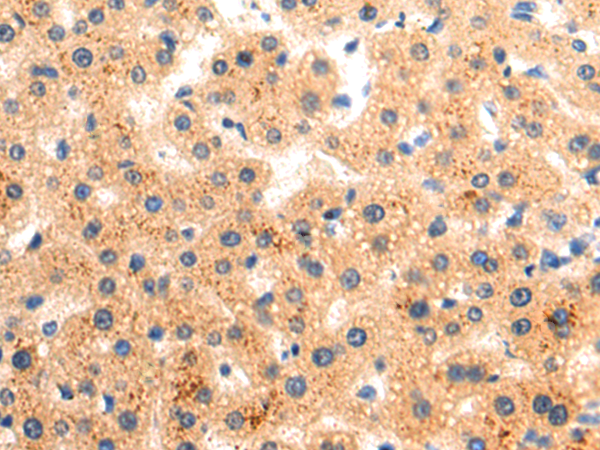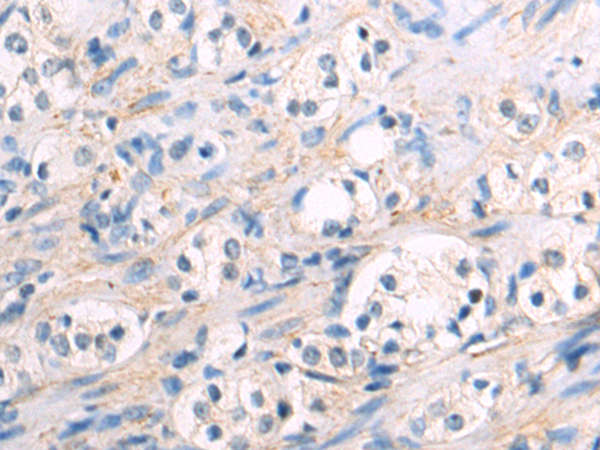

| WB | 咨询技术 | Human,Mouse,Rat |
| IF | 咨询技术 | Human,Mouse,Rat |
| IHC | 1/50-1/200 | Human,Mouse,Rat |
| ICC | 技术咨询 | Human,Mouse,Rat |
| FCM | 咨询技术 | Human,Mouse,Rat |
| Elisa | 1/5000-1/10000 | Human,Mouse,Rat |
| Aliases | LERN1; MRT64; LRRN6A; UNQ201 |
| Host/Isotype | Rabbit IgG |
| Antibody Type | Primary antibody |
| Storage | Store at 4°C short term. Aliquot and store at -20°C long term. Avoid freeze/thaw cycles. |
| Species Reactivity | Human, Mouse |
| Immunogen | Synthetic peptide of human LINGO1 |
| Formulation | Purified antibody in PBS with 0.05% sodium azide and 50% glycerol. |
+ +
以下是关于LINGO1抗体的3-4篇参考文献及其简要摘要:
1. **文献名称**:*LINGO-1 antagonist promotes spinal cord remyelination and axonal integrity in MOG-induced experimental autoimmune encephalomyelitis*
**作者**:Mi, S., Hu, B., Hahm, K., et al.
**摘要**:该研究于2008年发表在《Nature Neuroscience》,发现抗LINGO1抗体能够抑制LINGO-1信号通路,促进实验性自身免疫性脑脊髓炎(EAE)小鼠模型的少突胶质细胞分化和髓鞘再生,同时保护轴突完整性,为多发性硬化症的治疗提供了潜在策略。
2. **文献名称**:*Anti-LINGO-1 antibody enhances retinal ganglion cell survival and axon regeneration after optic nerve crush*
**作者**:Zhang, Y., Wang, D., Wang, H., et al.
**摘要**:2015年发表于《Journal of Neuroscience》,研究显示抗LINGO1抗体在视神经损伤模型中显著促进视网膜神经节细胞的存活和轴突再生,并改善视力恢复,提示其在视神经炎和青光眼等疾病中的治疗潜力。
3. **文献名称**:*Opicinumab (anti-LINGO-1) in relapsing multiple sclerosis: A randomized, placebo-controlled phase 2 trial*
**作者**:Rudick, R.A., Mi, S., Sandrock, A.W., et al.
**摘要**:2016年发表在《Neurology》,二期临床试验评估抗LINGO1抗体(opicinumab)对复发型多发性硬化症患者的效果。结果显示部分患者神经传导速度改善,提示髓鞘修复可能,但整体疗效未达主要终点,需进一步优化治疗方案。
4. **文献名称**:*Targeting LINGO-1 in experimental spinal cord injury: A promising approach for axonal regeneration*
**作者**:Lee, X., Yang, Z., Shao, Z., et al.
**摘要**:2014年发表于《Experimental Neurology》,研究在脊髓损伤模型中验证抗LINGO1抗体的作用,发现其通过阻断LINGO-1抑制信号,促进轴突再生和运动功能恢复,支持其在神经损伤修复中的应用前景。
这些研究共同表明,LINGO1抗体通过调控神经再生和髓鞘修复机制,在多种神经系统疾病中具有潜在治疗价值。
LINGO-1 (Leucine-rich repeat and immunoglobulin domain-containing protein 1) is a transmembrane protein predominantly expressed in the central nervous system (CNS), particularly in neurons and oligodendrocytes. It functions as a key component of the Nogo receptor complex, which negatively regulates neuronal growth, axon regeneration, and myelination. LINGO-1 interacts with signaling pathways such as the RhoA/ROCK cascade, inhibiting oligodendrocyte differentiation and myelination while promoting neuronal apoptosis. Its role in suppressing CNS repair mechanisms has made it a therapeutic target for demyelinating diseases like multiple sclerosis (MS) and spinal cord injuries.
Anti-LINGO-1 antibodies are designed to block LINGO-1 activity, aiming to enhance remyelination and neuroprotection. Preclinical studies demonstrated that LINGO-1 inhibition promotes oligodendrocyte maturation, axon regeneration, and functional recovery in animal models of MS and nerve injury. Clinical trials explored humanized anti-LINGO-1 antibodies (e.g., opicinumab) as potential MS therapies, though mixed results in phase II trials highlighted challenges in balancing efficacy and dosing. Emerging research also links LINGO-1 polymorphisms to Parkinson’s disease risk, expanding its potential therapeutic relevance. While clinical translation remains ongoing, LINGO-1 antibodies represent a novel strategy to address unmet needs in neurodegenerative and neuroinflammatory disorders by targeting intrinsic repair pathways.
×